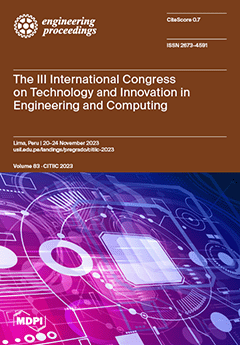Currently, in the grinding areas of Peruvian mining operations, there are linings made of various materials such as rubber and steel, all of which have a limited lifespan and eventually wear out. Understanding the wear behavior of these linings has a direct impact
[...] Read more.
Currently, in the grinding areas of Peruvian mining operations, there are linings made of various materials such as rubber and steel, all of which have a limited lifespan and eventually wear out. Understanding the wear behavior of these linings has a direct impact on mill performance. There are several solutions for measuring wear, making wear projections, and, most importantly, knowing the replacement date so that the mining company can schedule a plant shutdown. However, these solutions are not swift, as traveling to the mine, returning to the company, processing the data in software, and generating reports take 3 to 10 days depending on the workload of each supplier of these linings. Mining companies seek solutions to monitor the condition of their linings and avoid plant shutdowns as they disrupt production. The primary objective of this tool is to quickly and accurately predict the wear and removal of mill linings with user safety as a top priority. The product design and development process followed the methodology proposed by Ulrich and Eppinger, which includes (a) identifying customer needs, (b) planning, (c) developing product concepts, (d) system-level design, (e) detailed design, and (f) testing and refinement. Key metrics for design were defined through 50 surveys. Additionally, two focus groups with mill lining experts and user testing were conducted, allowing for the refinement and validation of the initial concept. The tool prototype was modeled in 3D, sensors and other electrical mechanisms were purchased, and an LED screen was programmed for data reading. Methodologies such as TRIZ, SCAMPER, and Canva were incorporated, facilitating a well-designed product with attention to detail. Finally, the final characteristics of the digital comb, ranging from 10′ to 25′, were defined and tested on mill linings, and with the help of the Weir Projection application, wear history and projections were rapidly generated. When compared with other measurement tools, minimal differences were found within a range of ±2 mm. Therefore, it is concluded that the prototype assists in quickly scheduling mill lining requirements in advance.
Full article




